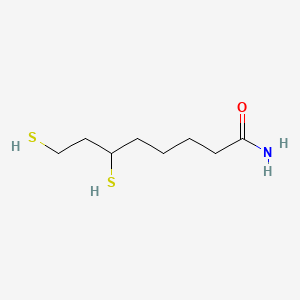| MeSH term | MeSH ID | Detail |
|---|---|---|
| Parkinsonian Disorders | D020734 | 20 associated lipids |
Dihydrolipoamide
Dihydrolipoamide is a lipid of Fatty Acyls (FA) class. Dihydrolipoamide is associated with abnormalities such as Wiskott-Aldrich Syndrome. The involved functions are known as Citric Acid Cycle, Electron Transport, NADH oxidation, Oxidation and Oxidants. Dihydrolipoamide often locates in Mitochondria, Mitochondrial matrix and Chloroplasts. The associated genes with Dihydrolipoamide are Mutant Proteins, Recombinant Proteins, mycothione reductase, Genes, Mitochondrial and alanylproline.
Cross Reference
Introduction
To understand associated biological information of Dihydrolipoamide, we collected biological information of abnormalities, associated pathways, cellular/molecular locations, biological functions, related genes/proteins, lipids and common seen animal/experimental models with organized paragraphs from literatures.
What diseases are associated with Dihydrolipoamide?
Dihydrolipoamide is suspected in and other diseases in descending order of the highest number of associated sentences.
Related references are mostly published in these journals:
| Disease | Cross reference | Weighted score | Related literature |
|---|
Possible diseases from mapped MeSH terms on references
We collected disease MeSH terms mapped to the references associated with Dihydrolipoamide
PubChem Associated disorders and diseases
What pathways are associated with Dihydrolipoamide
There are no associated biomedical information in the current reference collection.
PubChem Biomolecular Interactions and Pathways
Link to PubChem Biomolecular Interactions and PathwaysWhat cellular locations are associated with Dihydrolipoamide?
Visualization in cellular structure
Associated locations are in red color. Not associated locations are in black.
Related references are published most in these journals:
| Location | Cross reference | Weighted score | Related literatures |
|---|
What functions are associated with Dihydrolipoamide?
Related references are published most in these journals:
| Function | Cross reference | Weighted score | Related literatures |
|---|
What lipids are associated with Dihydrolipoamide?
There are no associated biomedical information in the current reference collection.
What genes are associated with Dihydrolipoamide?
Related references are published most in these journals:
| Gene | Cross reference | Weighted score | Related literatures |
|---|
What common seen animal models are associated with Dihydrolipoamide?
There are no associated biomedical information in the current reference collection.
NCBI Entrez Crosslinks
All references with Dihydrolipoamide
Download all related citations| Authors | Title | Published | Journal | PubMed Link |
|---|---|---|---|---|
| Oliver HF et al. | Deep RNA sequencing of L. monocytogenes reveals overlapping and extensive stationary phase and sigma B-dependent transcriptomes, including multiple highly transcribed noncoding RNAs. | 2009 | BMC Genomics | pmid:20042087 |
| Yin C et al. | Generation and analysis of expression sequence tags from haustoria of the wheat stripe rust fungus Puccinia striiformis f. sp. Tritici. | 2009 | BMC Genomics | pmid:20028560 |
| Rodrigues DF et al. | Architecture of thermal adaptation in an Exiguobacterium sibiricum strain isolated from 3 million year old permafrost: a genome and transcriptome approach. | 2008 | BMC Genomics | pmid:19019206 |
| Coker JA and DasSarma S | Genetic and transcriptomic analysis of transcription factor genes in the model halophilic Archaeon: coordinate action of TbpD and TfbA. | 2007 | BMC Genet. | pmid:17892563 |
| Chiu KP et al. | Pathway aberrations of murine melanoma cells observed in Paired-End diTag transcriptomes. | 2007 | BMC Cancer | pmid:17594473 |
| Kozlov G et al. | Structure of GlgS from Escherichia coli suggests a role in protein-protein interactions. | 2004 | BMC Biol. | pmid:15161493 |
| Schmidt MC et al. | Efficient α, β-motif finder for identification of phenotype-related functional modules. | 2011 | BMC Bioinformatics | pmid:22078292 |
| Mary-Huard T et al. | Statistical methodology for the analysis of dye-switch microarray experiments. | 2008 | BMC Bioinformatics | pmid:18271965 |
| Lee H et al. | An integrated approach to the prediction of domain-domain interactions. | 2006 | BMC Bioinformatics | pmid:16725050 |
| Xi Y et al. | Analysis on relationship between extreme pathways and correlated reaction sets. | 2009 | BMC Bioinformatics | pmid:19208161 |
| Goncalves S et al. | Rapid determination of tricarboxylic acid cycle enzyme activities in biological samples. | 2010 | BMC Biochem. | pmid:20109171 |
| Stern JM et al. | Radiofrequency ablation of small renal cortical tumours in healthy adults: renal function preservation and intermediate oncological outcome. | 2009 | BJU Int. | pmid:19426196 |
| Chakraborty S et al. | Characterization of a dihydrolipoyl dehydrogenase having diaphorase activity of Clostridium kluyveri. | 2008 | Biosci. Biotechnol. Biochem. | pmid:18391450 |
| Roy G and Mugesh G | Bioinorganic chemistry in thyroid gland: effect of antithyroid drugs on peroxidase-catalyzed oxidation and iodination reactions. | 2006 | Bioinorg Chem Appl | pmid:17497002 |
| Xie L et al. | A unified statistical model to support local sequence order independent similarity searching for ligand-binding sites and its application to genome-based drug discovery. | 2009 | Bioinformatics | pmid:19478004 |
| Takahashi T et al. | NADPH-dependent coenzyme Q reductase is the main enzyme responsible for the reduction of non-mitochondrial CoQ in cells. | 2008 | Biofactors | pmid:19096101 |
| Nordman T et al. | Regeneration of the antioxidant ubiquinol by lipoamide dehydrogenase, thioredoxin reductase and glutathione reductase. | 2003 | Biofactors | pmid:14695919 |
| Tam TK et al. | In situ regeneration of NADH via lipoamide dehydrogenase-catalyzed electron transfer reaction evidenced by spectroelectrochemistry. | 2012 | Bioelectrochemistry | pmid:22497727 |
| Tyagi TK et al. | Moonlighting protein in Starkeyomyces koorchalomoides: characterization of dihydrolipoamide dehydrogenase as a protein acetyltransferase utilizing acetoxycoumarin as the acetyl group donor. | 2009 | Biochimie | pmid:19383527 |
| LuÃs PB et al. | Valproic acid metabolites inhibit dihydrolipoyl dehydrogenase activity leading to impaired 2-oxoglutarate-driven oxidative phosphorylation. | 2007 | Biochim. Biophys. Acta | pmid:17706936 |
